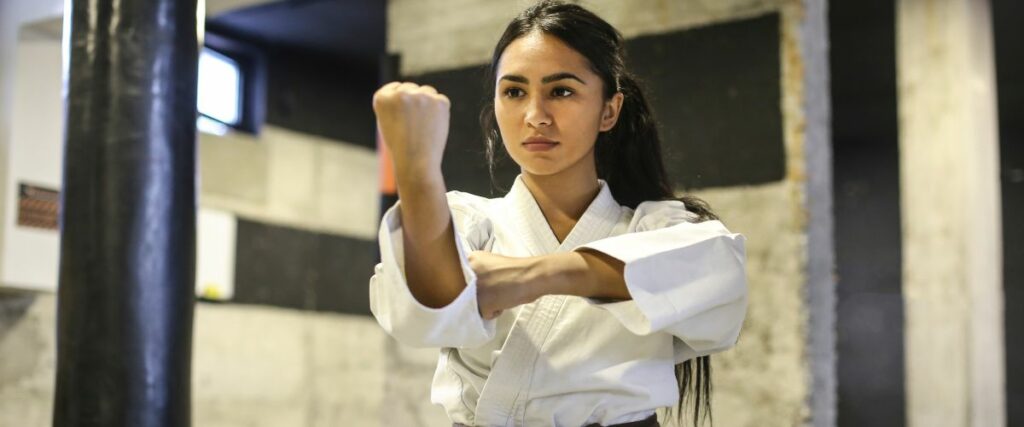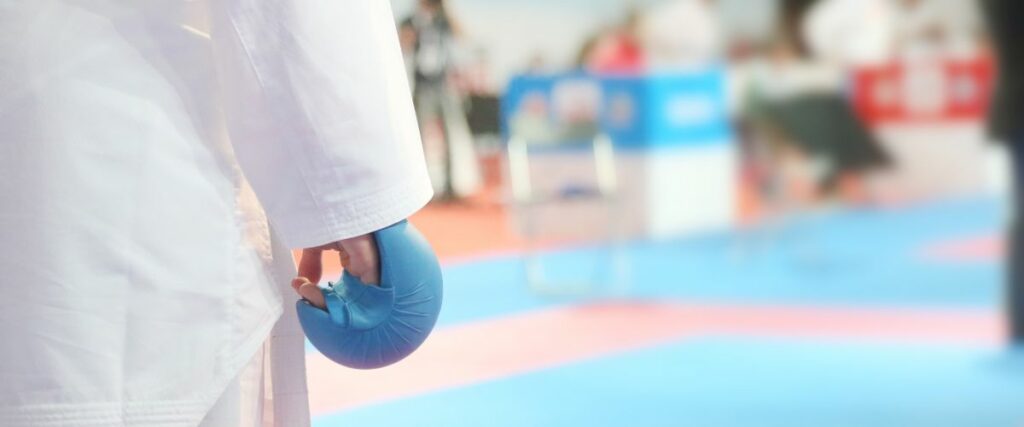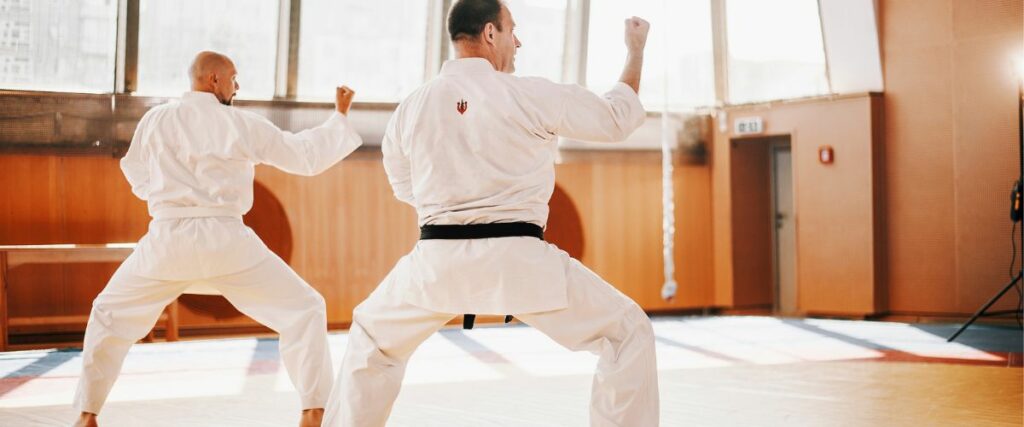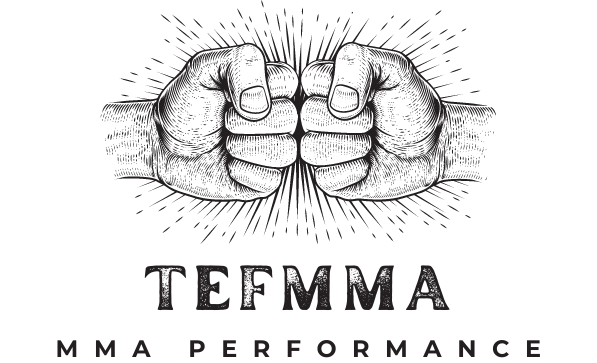Karate is one of the most popular martial arts in the world, and it served as a basis for many other styles that adopted different aspects of the Japanese martial art. MMA fighting uses all techniques that work regardless of where they come from, so it’s only natural that karate also plays a part in MMA. But how effective is it?
Karate has proven effective in MMA, but only after it combines skills from other martial arts. The traditional stance, lightning-fast lateral movement, and precise kicks transition well into MMA when the fighter understands and is prepared for all other aspects of MMA.
Many notable fighters successfully used karate in MMA. But how do you make karate work in MMA based on the accomplishments of some all-time greats?
History Of Karate

Karate’s origins are likely thousands of years old, but karate as we know it is only about 200 years old. Karate was developed on the Japanese island of Okinawa as a system for unarmed combat and self-defense.
The various cities in Okinawa had different approaches to fighting, which is still reflected in the differences between karate styles today.
In the early 20th century, the art of karate was introduced to mainland Japan. After a few years of systematical teaching around the country, karate became widespread. Its previous Chinese name of Tang changed to Karate (meaning open hand).
Most of the innovations we recognize today were implemented by the founder of Shotokan, Gichin Funakoshi. The use of the kimono as an official uniform and the colored belt system came from judo but were quickly adopted by karate and subsequently by many other styles around the world.
After World War II, American soldiers stationed in Okinawa started bringing karate to the States. In the 1970s, mainly through martial arts films and traveling karate teachers, the martial art became a worldwide phenomenon. Today, millions of people practice different forms of karate, literally all over the world.
Is Karate Good For MMA?

Early in MMA’s history, it looked like the questions of which martial arts are practical and which are not were resolved. Still, the ever-evolving nature of the sport constantly brings out new methods and techniques that work well in the cage and changes the perception of what is effective.
Karate alone is not sufficient for MMA. The lack of grappling (at least in the most popular styles we are discussing) means a karateka is woefully unprepared for anything outside of striking at distance. Another downside of point fighting styles like Shotokan (by far the most popular style of karate) is that there is no full contact sparring and competition.
But many of the striking principles of karate are very good for MMA. Point karate fighters have incredible fencer-like movement, agility, and speed in their strikes and footwork. Fighters like Lyoto Machida and Stephen Thompson added new layers to top off their karate.
They made it brutally effective in the Octagon while still retaining their core karate principles. This, in fact, goes for pretty much every martial art, so with sufficient adjustments, karate is good for MMA.
Here is what the most successful karateka in MMA has to say on the subject:
Best Style Of Karate For MMA
A critical point we haven’t touched on until now in this article is the styles of karate. Karate is far from an amorphous style like Muay Thai or jiu-jitsu. There are dozens of styles of karate that can vary so much in techniques that they share only the traditions and structure of karate.
The most popular style is Shotokan karate, and other point-based styles stem from it. This is what most people who are not that well educated in martial arts imagine karate to be.
And this style, with its specifics, is most commonly used in MMA circles to describe what is “karate” inside the cage. Lyoto Machida and Stephen Thompson come from a point-based karate style.
The other school of karate is Kyokushin and all of its sub-styles. This full-contact karate does not play the point game, but the competition aims to knock down your opponent.
However, there are no strikes with the hands to the head, which changes things quite a bit. George St. Pierre and Bas Ruten had a Kyokushin background. Still, this style is less pronounced in the cage as it resembles more kickboxing when you add punches to the head.
There are other karate styles, some of which are better for MMA than others. One of them, called Kudo, is basically MMA with a kimono and head-butts. Still, these styles are too niche and have little representation in MMA. All talks of efficiency in the cage are purely theoretical.
Effective Karate Techniques In MMA

There are many techniques in karate that work well in MMA. But here, we will list a few that karate specialists have widely used in the cage. They are also decidedly “karate,” as these techniques are standard in karate competitions and can rarely be seen used by other fighters.
Wide Stance And Footwork
The point styles of karate (amongst other traditional martial arts) use a wide and bladed stance. Another critical component is that the fighter is always on the balls of his feet and is usually bouncing constantly.
This stance has pros and cons, but its most crucial aspect is that it allows for the fastest forwards and backward movement.
The traditional wide stance can also be very effective in MMA. It has been shown not only by pure karatekas like Machida and Thompson but also by fighters like Connor McGregor, Daren Till, Gunnar Nelson, and others. This stance and footwork also serve as the basis for the other techniques we will look at shortly.
Here is a detailed explanation of the side stance:
And another one detailing more how Lyoto Machida moves in the cage
Blitzing Punches
Much like in fencing, exploding in and tagging the opponent first is a key concept of karate. This principle also works in MMA; the punch blitz is a great way to close the distance and tag your opponent. This technique is a combination of alternating straight punches with forward movement.
There is no better man to show you how to the blitz than Wonderboy:
Side Kick
The dreaded side kick is a staple of both karatekas and taekwondo guys. The side stance we discussed above places the lead leg in a perfect position to be fired at any time. The side kick is much like a foot jab. It can have many applications, like gauging the distance, stopping an incoming opponent, annoying him, or even knocking him out.
You can use the side kick at all levels. Most karate guys use it predominantly on the body, but others, like Jon Jones, have found great success with the side kick to the leg.
Here is a short compilation that perfectly illustrates the variety of the side kick in MMA:
Lead High Kick
There are two main ways to roundhouse kick. The Muay Thai way of a thunderous full force kick with the shin and the fast snapping kicks with the foot in karate. Both have their advantages, but the karate version is the fastest head kick you can throw.
Unlike the loading switch kicks most fighters throw, the karate version is lightning fast and much harder to react to. With the proper technique, it can also carry some serious power.
We once again turn to Wonderboy Thompson for detailed instruction, not only as a great karate guy in MMA but also as the owner of one of the best martial arts channels on YouTube:
Successful Karateka In The UFC
More than a few karate masters reaped great success in the cage using their traditional skills. Of course, these men altered their base skills and complimented them greatly with other disciplines to compete at a high level in MMA.
Here are some of the most remarkable examples to study if you want to learn how karate transfers into MMA.
Lyoto Machida
We have to start with arguably the best karateka in MMA, Lyoto the Dragon Machida. The Brazilian entered the UFC with a bang in 2007 and eventually became the light heavyweight world champion.
He was trained in Shotokan karate, but he and his brother reworked the style (now called Machida karate) to work better in MMA. The Dragon was a master of dictating range and blitzing in with punches.
His lightning-fast kicks and footwork bewildered his opponents, especially early on, as he was one of the pioneers of using traditional karate in MMA.
Stephen “Wonderboy” Thompson
Stephen “Wonderboy” Thompson is another perfect example of using karate in MMA. Just like Lyoto, Thompson is the son of a karate master and started practicing as a very young kid. Wonderboy started competing in kickboxing at age 15 and went undefeated in 37 fights.
His perfect kickboxing run continued as a pro, where he won 58 fights before finally transitioning into MMA. Despite not winning a UFC title, Wonderboy has been a top welterweight throughout his career.
His wide-bladed stance and crafty kicks proved too much for most of his opponents and are a prime example of classic karate skills in MMA.
George St. Pierre
GSP is undoubtedly one of the best to do it, and he credits much of his success to his Kyokushin base. Early in his career, he liked to make his cage entrance in a traditional kimono as a nod to his background.
While the karate is not as pronounced in GSP’s style as it is with Machida and Thompson, his blitzing jabs and powerful kicks still carry a lot of “traditional” flavor.
On top of that, GSP came from Kyokushin, which does not use a wide stance and instead emphasizes more short-range strikes with great power. So it’s easy for fans not knowledgeable in the various Japanese styles not to recognize some things he does as “karate.”
Kyoji Horiguchi
I want to include a fighter that may not be mainstream but may well be the best karate guy in MMA, Kyoju Horiguchi. He describes his style as 100% karate. Horiguchi had a great run in the UFC, where he lost only once.
He then went on to win the Bellator and Rizin FF bantamweight belts simultaneously. Of course, Horiguchi is also very good at wrestling and incorporates other styles into his fighting. Still, he is another prime example of traditional karate in MMA.
Summary
Just like with all other martial arts, karate is effective for MMA when sufficiently altered and modified to the needs of MMA. Then every karate guy must become proficient at ground fighting before he has any chance in MMA matches. But as many great talents have proved, karate can be very good for MMA when used correctly.
